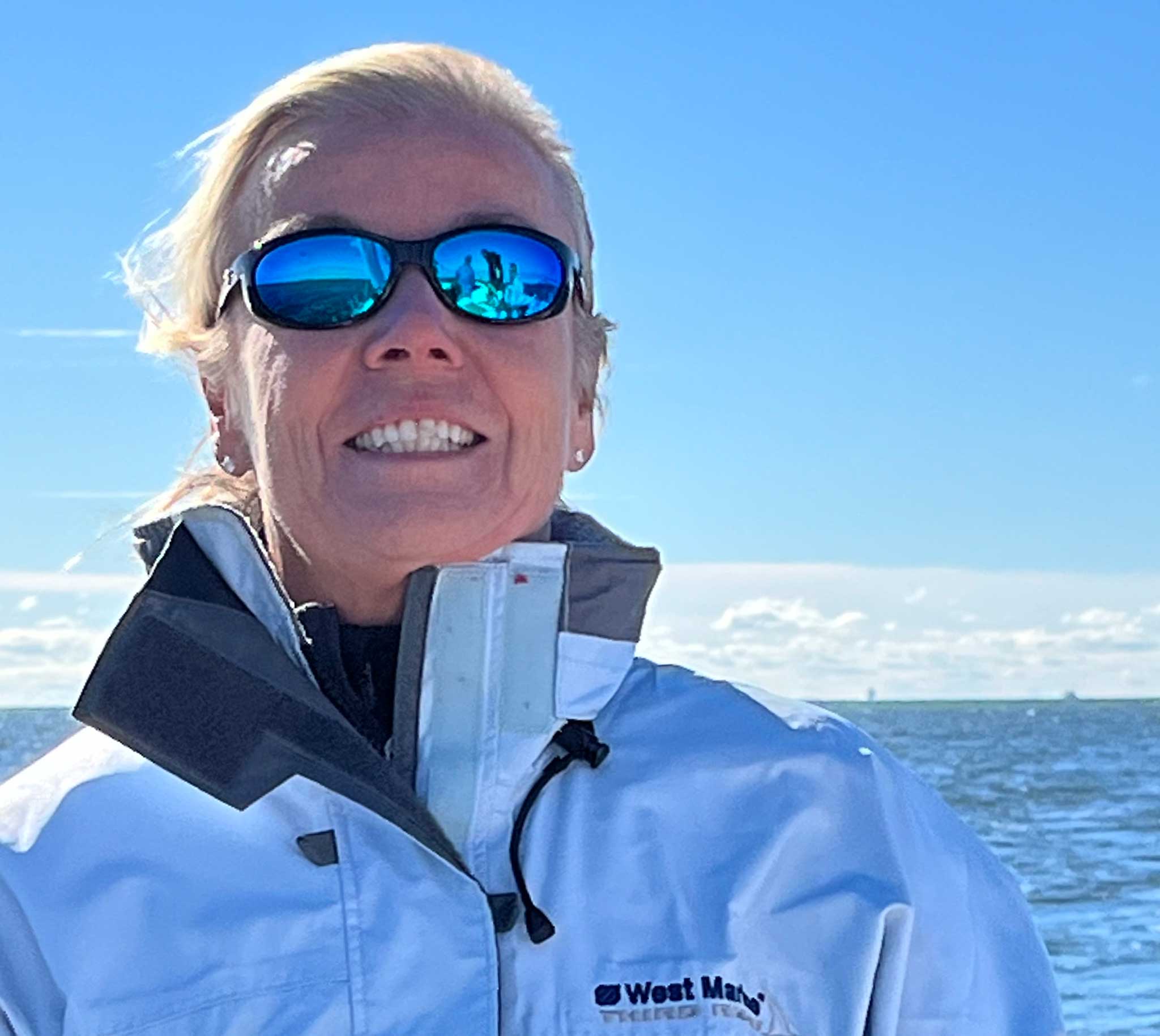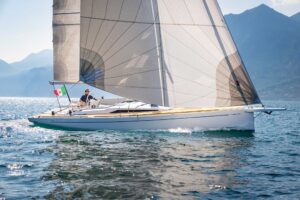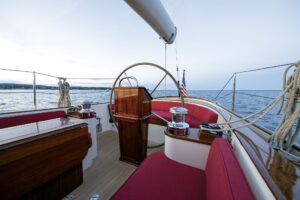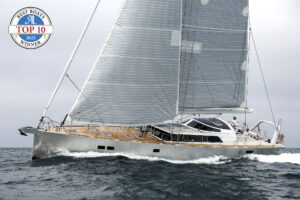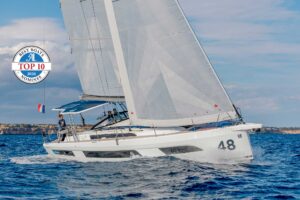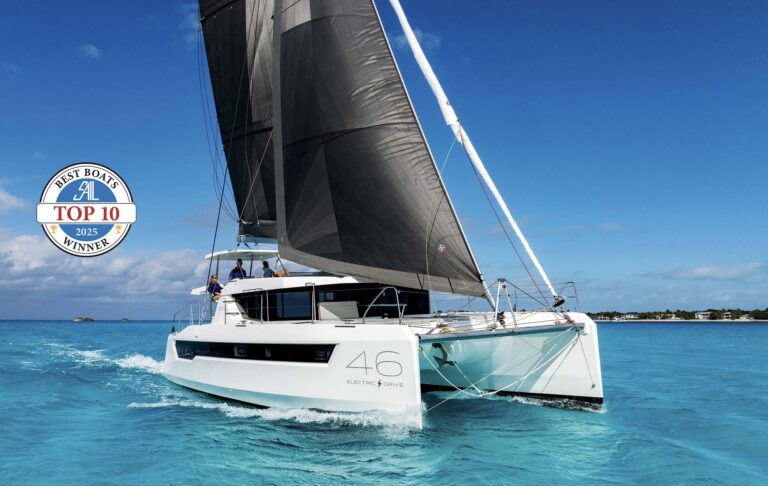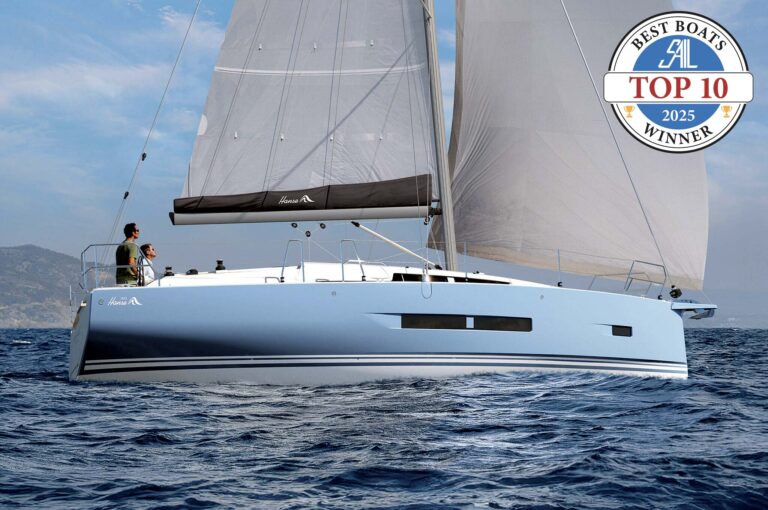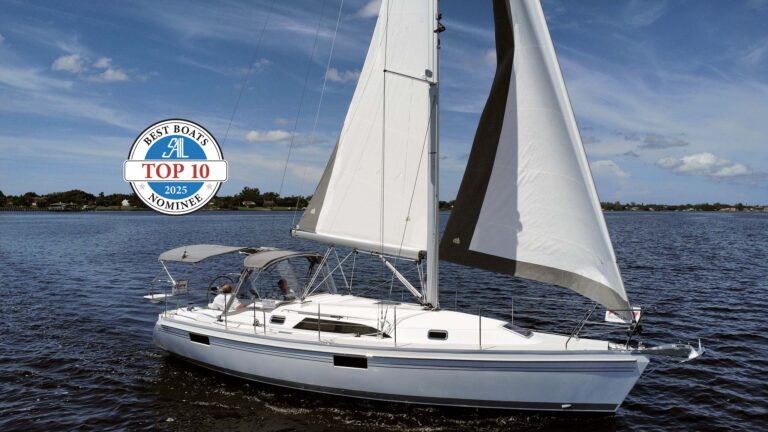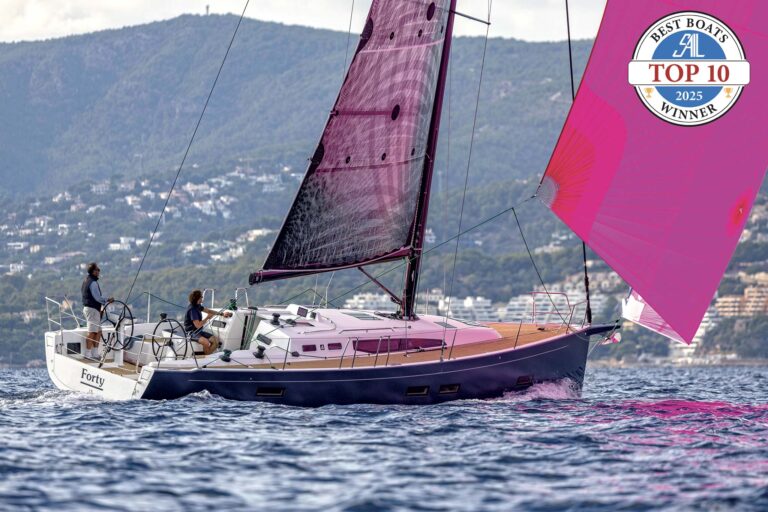
“I’m a racer, and I don’t like the sound of engines,” said Stephane with a laugh as he showed me around Awen, his sleek and recently launched Outremer 52. “We wanted to sail more and motor less, which is why we went with Outremer.”
This sentiment is pervasive among Outremer owners who together have logged some 2.3 million miles over the company’s history. As new models are introduced, more adventurers are made, and that’s about to heat up with the launch of the latest design. The Outremer 52 replaces the very popular 51, of which 101 were sold. Those are some big shoes to fill, but the new model has already rung up more sales than any other semi-production performance cruising cat in the same time frame.
This latest VPLP design has borrowed features from the Outremer 55 and combined them with the best of her predecessor. The adjustable helm, the larger forward windows in the salon, the increased volume, and the double helm seat set longitudinally are welcome features. And although she’s a bit heavier than her predecessor, the 52 also carries more canvas, so she’s speedier.

Narrow hulls and deep, straight daggerboards define Outremer and their reputation for fast cruising. On the 52, the designers have focused on refining the layout and ergonomics starting with the helm area, which is raised on the starboard bulkhead and divided into zones.
First is the linehandling area with two electric winches to manage the halyards, sheets, and reefing lines. Second is a leaning post aft of the winch station where you stand to steer or manage the throttles on the left-hand side. With this setup, it’s easy for one person to steer and the other to manage lines without getting in each other’s way yet staying in immediate communication. It’s also easy for one person to set the autopilot and, with two steps forward, handle sails.
On deck and outboard is the third zone with the helm seat that runs fore-and-aft. It can seat two people facing inboard or one lounging and looking forward, making a nice place to sit and drive.
The fourth zone is in the cockpit, where you can steer and manage some of the lines while staying better protected from the elements. (The other notable sailhandling feature is the heavy-duty mainsheet traveler aft of the cockpit seats, with multiple jammers and winches on either side for good, low control of this 1,023-square-foot sail.)

These multiple zones are made possible by the Jefa helm that easily swings and locks into three positions from low in the cockpit to straight up at the standing helm to outboard towards the seat. The B&G multifunction display rotates so it’s visible from all angles as well.
Two things I found tricky in this setup. First, there are no handholds when you come up the steps from the cockpit, and it’s tempting to grab at the wheel in unsteady conditions. Second, it’s hard to see the opposite bow from the leaning post. You can duck down and look through the salon windows, but if you’re not tall, even stepping well outboard won’t show you the port bow.
The 52 is available with the versatile wheel, with twin long tillers, or with one of each, which is how our boat was equipped, with the tiller occupying the port side steering. Stephane, who is a true racer, said he’s tried the tiller once or twice and liked it but it’s not a go-to feature for him. It wasn’t installed during our sea trial, so I didn’t experience it.
Stephane and his wife, Holly, opted for a Lorima carbon mast to lower the weight aloft but combined it with an aluminum V-boom to hold the mainsail. A self-tacking jib is standard, but Stephane spec’d a staysail and a genoa with 3D sheeting that eliminates the coachroof track and adds an outboard control line that sheets in or opens up the slot as needed.

The black North Sails with 3Di filament technology looked no worse for the wear even after 6,000 miles and an Atlantic crossing from the Canary Islands to Martinique and then Miami for the boat’s U.S. debut at the Miami International Boat Show in February. On its best day on this multi-leg passage, the boat logged 254 miles with a top speed of 21.3 knots.
Our sail took place in lumpy seas and shifting winds off Miami Beach. The big wind had come through the day before, but the sketchy breeze wasn’t going to dampen our fun. In 10 knots of true breeze, we made good 6.1 knots of boatspeed. In the puffs you could immediately feel the boat accelerate as she jumped up to 9.2 knots in 14 knots of wind. We had a 1-foot chop over a 3-foot swell, but the narrow hulls sliced the waves like knives through butter. The helm was light with excellent feedback, and you could feel the rudder humming as we managed a boatspeed of two-thirds of the windspeed in all directions and pointed up to 40 degrees.
Awen is hull No. 4 and carries twin Australian 50-hp Nanni diesels on saildrives. “The Nannis have less vibration and are quieter,” explained Stephane. These engines are sufficient to cut through chop and deliver an 8-knot cruise at 2,500 rpm. Electric propulsion is possible. Two hatches in each hull aft of the helms open to provide full access to the diesels, rudder quadrants, and other mechanicals.

The foredeck differs from those on more typical production cats. The longeron separates two very long trampolines, which terminate aft in a short hard deck with stowage lockers and the windlass below. Just aft of the windlass, three steps take you up to the coachroof to access the mast, boom, and mainsail. Additional netting forms triangles ahead of the crossbeam making it easier to work at the bowsprit. These also make great lounges over the water, although it was a bit boisterous on our sail to test this out.
Outremer rethought the liveaboard factor with this model, because although it’s a performance cat, owners still live on their boats for extended periods. In the cockpit, an L-shaped seat runs across the transom and up the starboard side, facing forward to the port side bar area by the galley window. It creates the back of a congenial space which accommodates a crowd. If you’d rather watch the rooster tails in the wake, you can sit at the portside lounge and face aft. The dinghy davits carry 800 watts of solar panels with another 1,200 watts up on the bimini, so there’s decent energy autonomy at anchor.
The galley faces aft and is L-shaped. Two cooks can work together although the counter space isn’t terribly generous. Refrigeration is forward by the nav desk in the port corner. That nav desk is spacious and practical, with full visibility forward and a dedicated, robust chair that articulates to face the galley or dining space to starboard.
The owner’s suite commandeers the entire starboard hull with a queen-sized bed aft, a head forward, and surprisingly plentiful storage in between. The port hull has forward and aft cabins with a split head in the middle that is shared. A modular “free space” forward here can be configured in multiple ways, from an office and workshop with convertible bunk, to a double cabin or child’s cabin.

The finishes are practical if fairly standard. Alpi wood keeps the weight down, although the effect is reminiscent of production cats rather than luxury cruisers in this class.
Outremer excels at fostering a community. They’re experts at building direct relationships with owners, which has been the secret sauce to their sales success. Outremer Week gatherings, women’s programs, and technical training for owners in La Grande Motte near the factory make potential buyers feel like they’re buying more than a boat; they’re buying into a family of like-minded adventurers.
“I like the boat because it’s lean, modern, and a bit bad-ass,” said Stephane. “Holly likes it because she feels the boat is confident in all situations and gives her a feeling like, ‘I’ve got you.’ ”
It’s no surprise, then, that there are more than 70 Outremer 52s already on order, which brings the lead time to get one to 2027 despite the $2 million price tag. Outremer has announced that they’re opening a second facility specifically to build the 52, but that still won’t put you onto one in less than two years. But anyone who absolutely wants to globetrot with the potential of 250-mile days will likely stick out the wait time to get a model that lets them sail more and motor less.

LOA 51’7”
Beam 25’11”
Draft 3’6” (boards up), 6’8” (boards down)
Air draft (w/out antenna) 75’6”
Displacement 28,219 lbs (34,000 loaded)
Sail Area 1,507sq ft upwind, Genoa 646 sq ft; Gennaker (optional) 1,507 sq ft; Spinnaker (optional) 2,271 sq ft
Power Nanni 2x 50-hp
Designer VPLP Design
Builder Outremer catamaran-outremer.com
As-tested $2 million
Grand Large Yachting, which owns Outremer Catamarans, is holding its Blue Water Sailing Seminar at the U.S. Sailboat Show in Annapolis on October 12, 2024. Geared to helping aspiring cruisers learn how to plan for and achieve their dream, the seminar taps into expertise from seasoned sailors and provides a place for conversation about all aspects of long-distance cruising. For more information: https://grandlargeservices.com/en/evenements/seminaires-grande-croisiere/
Meet the Other 2025 Top 10 Best Boats Nominees

For more multihull reviews and stories, subscribe for free to Multihull Power & Sail
June/July 2024

